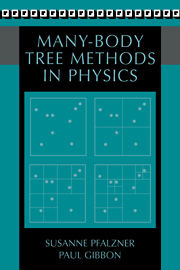Book contents
- Frontmatter
- Contents
- Preface
- Errata
- 1 Introduction
- 2 Basic Principles of the Hierarchical Tree Method
- 3 Open Boundary Problems
- 4 Optimisation of Hierarchical Tree Codes
- 5 Periodic Boundary Conditions
- 6 Periodic Boundary Problems
- 7 The Fast Multipole Method
- Appendix 1 Multipole Expansion in Two Dimensions
- Appendix 2 Spherical Harmonics
- Appendix 3 Near-Neighbour Search
- Refrences
- Index
2 - Basic Principles of the Hierarchical Tree Method
Published online by Cambridge University Press: 11 September 2009
- Frontmatter
- Contents
- Preface
- Errata
- 1 Introduction
- 2 Basic Principles of the Hierarchical Tree Method
- 3 Open Boundary Problems
- 4 Optimisation of Hierarchical Tree Codes
- 5 Periodic Boundary Conditions
- 6 Periodic Boundary Problems
- 7 The Fast Multipole Method
- Appendix 1 Multipole Expansion in Two Dimensions
- Appendix 2 Spherical Harmonics
- Appendix 3 Near-Neighbour Search
- Refrences
- Index
Summary
Tree Construction
We have seen in the preceding chapter that in grid-based codes the particles interact via some averaged density distribution. This enables one to calculate the influence of a number of particles represented by a cell on its neighbouring cells. Problems occur if the density contrast in the simulation becomes very large or the geometry of the problem is very complex.
So why does one bother with a grid at all and not just calculate the interparticle forces? The answer is simply that the computational effort involved quite dramatically limits the number of particles that can be simulated. Particularly with 1/r-type potentials, calculating each particle–particle interaction requires an unnecessary amount of work because the individual contributions of distant particles is small. On the other hand, gridless codes cannot distinguish between near-neighbours and more distant particles; each particle is given the same weighting.
Ideally, the calculation would be performed without a grid in the usual sense, but with some division of the physical space that maintains a relationship between each particle and its neighbours. The force could then be calculated by direct integration while combining increasingly large groups of particles at larger distances. Barnes and Hut (1986) observed that this works in the same way that humans interact with neighbouring individuals, more distant villages, and larger states and countries. A resident of Lower-Wobbleton, Kent, England, is unlikely to undertake a trip to Oberfriedrichsheim, Bavaria, Germany, for a beer and to catch up on the local gossip.
- Type
- Chapter
- Information
- Many-Body Tree Methods in Physics , pp. 9 - 36Publisher: Cambridge University PressPrint publication year: 1996



